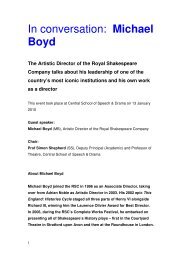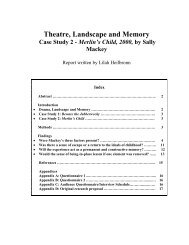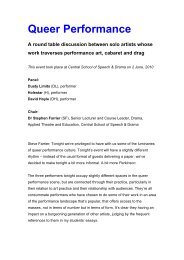the puppet as a figure of the other final P PIRIS 2013 - Central ...
the puppet as a figure of the other final P PIRIS 2013 - Central ...
the puppet as a figure of the other final P PIRIS 2013 - Central ...
- No tags were found...
Create successful ePaper yourself
Turn your PDF publications into a flip-book with our unique Google optimized e-Paper software.
cl<strong>as</strong>sification on such a b<strong>as</strong>is seems to be not that productive. I suggest that it is morepertinent to look at <strong>the</strong> materialisation <strong>of</strong> <strong>the</strong> physical engagement between <strong>the</strong>manipulator and his <strong>puppet</strong>. I propose to turn to a ‘body against body’ analysis inspiredby <strong>the</strong> cl<strong>as</strong>sification <strong>of</strong>fered by Stephen Kaplin (1999) which looks at <strong>the</strong> levels <strong>of</strong>engagement between <strong>the</strong> body <strong>of</strong> <strong>the</strong> performer and <strong>the</strong> ‘body’ <strong>of</strong> <strong>the</strong> <strong>puppet</strong>. Theselevels <strong>of</strong> engagement range from an absence <strong>of</strong> physical contact between <strong>the</strong> humanbeing and <strong>the</strong> object to <strong>the</strong> possession <strong>of</strong> <strong>the</strong> human body by <strong>the</strong> <strong>puppet</strong>. In between<strong>the</strong>se two extreme relationships, <strong>puppet</strong>eers and <strong>puppet</strong>s coexist on stage in a sort <strong>of</strong>“close distance” that renders possible <strong>the</strong> fact that both <strong>the</strong> manipulator and <strong>the</strong> <strong>puppet</strong>can exist in a relative autonomy. In <strong>the</strong> following section, I describe <strong>the</strong>se levels <strong>of</strong>engagement with examples <strong>of</strong> key artists in each c<strong>as</strong>e.2.2.1. Motionless animationOne level <strong>of</strong> involvement between <strong>the</strong> <strong>puppet</strong>eer and <strong>the</strong> <strong>puppet</strong> consists <strong>of</strong> <strong>the</strong>paradoxical absence <strong>of</strong> contact between <strong>the</strong> two <strong>of</strong> <strong>the</strong>m. Yet, if <strong>the</strong> principle <strong>of</strong><strong>puppet</strong>ry entails <strong>the</strong> manipulation <strong>of</strong> an object in order to transform it in front <strong>of</strong> anaudience into an animated being, how is it still possible to talk about <strong>puppet</strong>ry? Artistsengaged in this form <strong>of</strong> <strong>puppet</strong>ry, such <strong>as</strong> Christian Carrignon <strong>of</strong> French companyThéâtre de Cuisine, believe that even if <strong>the</strong> object is not animated, it gains <strong>the</strong> status <strong>of</strong>an animated being because <strong>of</strong> <strong>the</strong> involvement <strong>of</strong> <strong>the</strong> performer with <strong>the</strong> object. Frenchscholar Jean-Luc Mattéoli calls this form <strong>of</strong> <strong>puppet</strong>ry ‘motionless manipulation’. At <strong>the</strong>conference on The Presences <strong>of</strong> <strong>the</strong> Puppeteer, he defined it in <strong>the</strong> following terms: ‘<strong>the</strong><strong>puppet</strong> becomes motionless and <strong>the</strong> performer circles around it’ (Mattéoli 2009). Thisform <strong>of</strong> performance uses salvaged objects (also called impoverished objects) that mayhave a story <strong>of</strong> <strong>the</strong>ir own and that had a primary function <strong>as</strong>ide from being objects for48






